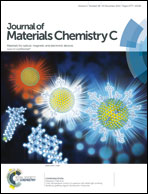Hollow nanocubes made of Ag–Au alloys for SERS detection with sensitivity of 10−8 M for melamine†
Abstract
In this work, we transformed Ag nanocubes into Ag–Au hollow nanocubes with a continuous shell of Ag–Au alloy on the surface and some remaining pure Ag in the interior. Upon the removal of the pure Ag with aqueous H2O2 from inside of Ag–Au hollow nanocubes, we obtained Ag–Au nanoboxes. Next, we systematically evaluated the SERS properties of the hollow nanocubes and nanoboxes by benchmarking against the Ag nanocubes. In one study, we collected the SERS spectra of 1,4-benzenedithiol (1,4-BDT) adsorbed on the surfaces of the nanoparticles when the samples were prepared using 1,4-BDT solutions with different concentrations. Our results showed that both the hollow nanocubes and nanoboxes exhibited considerably stronger SERS activity than the original Ag nanocubes. In particular, the remaining pure Ag inside the hollow nanocubes made a significant contribution to achieve SERS detection with sensitivity of 10−11 M for 1,4-BDT. We further demonstrated their capability for the SERS detection of melamine at 10−8 M, a concentration considerably lower than the tolerance level of 1 ppm in infant formula. Moreover, we showed that the hollow nanocubes or nanoboxes with Ag–Au alloy shells on the surfaces were more stable compared to Ag nanocubes in an oxidative environment such as a solution containing an oxidant and/or halide ions. Taken together, these Ag–Au alloy nanostructures are good candidates for a trace detection of biological and chemical analytes by SERS.


 Please wait while we load your content...
Please wait while we load your content...